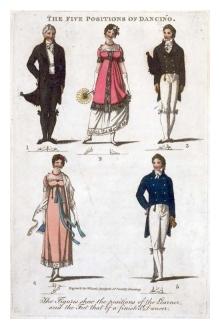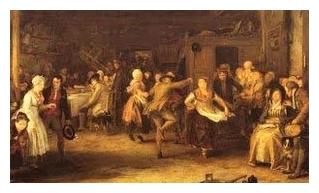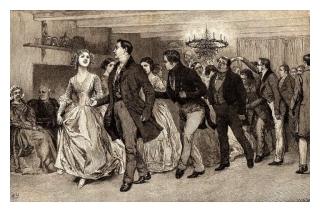A BRIEF HISTORY OF SCOTTISH COUNTRY DANCING
The Country Dance
The Country Dance, probably (or possibly, as there is some dispute) a corruption of the French 'contra danse', is a form of dance in which several couples dance opposite each other in typically longwise sets. It originated in England during the 17th century, although its roots go back as far as the Court of Elizabeth I.

John Playford, a bookseller to the Inns of Court in London, published The English Dancing Master, a collection of Country Dances in 1651 which ran to its 18th edition in 1728! At the close of the 17th century most of the dances were in the form of a longwise set with the defining and ingenious device of the 'progression'. This allowed each dancing couple to have its turn at the top, and then progress down the set to second and third places, etc.
The tunes used, which often gave name to the dances, were mostly traditional song tunes, and significantly many of them were Scottish or Irish. Dancing schools existed to teach each season's new dances.

The Country Dance spreads
The 18th century in Scotland was a time of repression of Scottish culture and, in particular, the suppresion of the Jacobite cause. But later on in this century, with an increase in lowland Scotland's prosperity, Edinburgh rose in status, and formal balls and assemblies, at which Country Dances were performed, became part of the cultural life. Similar, formal dance styles developing in the French Court were also based on the English Country Dance. There was a conviction in both England and Scotland that the French forms represented the highest art of formality and gentility, no doubt led by the dancing masters of the time being trained in French dance technique that we now associate with ballet.
The French association was strong, and resulted in several of the dance movements in both English and Scottish Country Dance having French names, for example 'allemande' and 'poussette''. The French form called the Contredanse or Cotillon subsequently led to the Quadrille, which took over from Country Dances at society balls in England during the 19th century, and also crossed the Atlantic to become the root of Square Dancing. This is also considered the origin of the 'round the room' type dances we are familiar with in Ceilidh and Barn dances. Away from the main centres of 'society', and particularly in rural areas, Country Dancing remained popular.
Scottish Country Dance develops
The Scots did not abandon the Country Dance, but early on started to modify it by introducing more intricate steps, and elements of the separate, indigenous Highland reels that allowed more 'exuberent expression' of the Scottish music's character. 
These Highland traditions, which extended out to the islands, as far as the Shetlands, were based on a simpler structural form. A series of alternating circles, or reels, and setting steps were danced, the variations and intricacy of the setting steps, and the vigour of both music and dancers being the distinctive features. This is the source of the Threesome Reel (based on the reel of three), the Foursome Reel (reel of four, illustrated) - both Highland Dances, not Country Dances - and later, together with elements of the Quadrille, the Eightsome Reel - a Country Dance.
The step dancing of Scotland - Highland and Ladies Step Dancing, which are essentially solo forms, and are to be best seen at the various Highland Games - should not be confused with Country Dancing, even though a few 'Highland Steps' have made their way into a small number of Scottish Country Dances.
The defining character
This character of intricacy and precision, in both footwork and figure, became the hallmark of the many Dancing Masters in Scotland during this period of late 18th and 19th centuries. These itinerant teachers taught all the current forms of dance, minuet, country dance, highland reels and 'high' dances (we now call 'Highland') both to the 'gentles' in the drawing room, and the 'simples' in the servants quarters, of grand Scottish houses.
This classlessness is evidenced by numerous accounts, such as one from Elizabeth Grant on dances at the Duchess of Gordon's house;
"A few candles lighted up bare walls at short warning, fiddles and whisky punch were always at hand, and the gentles and simples reeled away in company".
The Dancing Masters would also devise their own dances for these occasions, often to honour their patrons, so it was natural that the forms mixed, and for a Scottish style of the Country Dance to develop. The introduction of the energetic, springing steps and the figures of 'set to and turn corners', and soon after the 'reel of three' and 'reel of four', mark a true separation of the English and Scottish Country Dance traditions.
Dancing Masters in the 19th century commonly had studied ballet in London or Paris, and introduced the five ballet foot positions, pointed foot and straight knees to the style of dancing for both the country dance and the high dances. This was the origin of the 'technique' we now associate with Scottish Dancing and which the more dedicated Scottish dancers aspire to achieve. The rest of us can relax in the knowledge that our footwork is from an earlier age when bent limbs were the norm!
A shared tradition
 It would be wrong to think that the English and Scottish dances went their separate ways entirely. In the country areas of England, for example, Scottish dances were included in the repertoire alongside English dances up to the end of the nineteenth century, and the dance tunes were shared extensively. Thomas Hardy, in his novels and poems written in Dorset, mentions over forty Country Dances, with over a dozen of these being Scottish Dances we still know today. Hardy certainly based this on his personal experience as he, his father and grandfather were all musicians who played for Country Dancing. They collected many dance tunes in their own manuscript books, and many of these tunes are played by Scottish dance bands today.
It would be wrong to think that the English and Scottish dances went their separate ways entirely. In the country areas of England, for example, Scottish dances were included in the repertoire alongside English dances up to the end of the nineteenth century, and the dance tunes were shared extensively. Thomas Hardy, in his novels and poems written in Dorset, mentions over forty Country Dances, with over a dozen of these being Scottish Dances we still know today. Hardy certainly based this on his personal experience as he, his father and grandfather were all musicians who played for Country Dancing. They collected many dance tunes in their own manuscript books, and many of these tunes are played by Scottish dance bands today.
The modern legacy
Country Dancing waned towards the end of the 19th century, and by the end of the First World War was at risk of being lost. Fortunately for us, Mrs Ysobel Stewart of Fasnacloich (head of training for Girl Guides in Scotland) set about restoring the old social dances of Scotland, and found in Miss Jean Milligan (principal PT instructor at Jordanhill, Glasgow) a person capable of helping her achieve that aim. Together they founded what was later to become the Royal Scottish Country Dance Society (RSCDS), and started the task of collecting the dances and writing them down in a standard notation. The formations and steps were also revised and standardised by Miss Milligan, with the effect that Scottish Country Dancing became distinct from the previous centuries Country Dancing. **
Although this redefinition and standardisation undoubtedly lost some of the variety and richness of the earlier periods, it has allowed Scottish Country Dancing to spread out across the world using a common language and style. It is promoted as representing the ballroom dancing of Scotland in the 18th and 19th centuries, although in reality, as noted already, it has always been classless, and simply the social dancing of Scotland. There are now Scottish Country Dancing societies in all major cities worldwide, and a warm welcome awaits any traveller who drops in for an evening's dancing.
Scottish Country Dancing to spread out across the world using a common language and style. It is promoted as representing the ballroom dancing of Scotland in the 18th and 19th centuries, although in reality, as noted already, it has always been classless, and simply the social dancing of Scotland. There are now Scottish Country Dancing societies in all major cities worldwide, and a warm welcome awaits any traveller who drops in for an evening's dancing.
The RSDCS is still hugely important in maintaining and developing Scottish Country Dancing through its many local branches, and by training teachers and publishing new dances. However, very many other clubs and societies have also grown up to spread the enjoyment of dancing further, but still based on this common language. Creativity remains undiminished for devising new dances, and dance figures, and there are thought to be well over 10,000 published dances.
** Around the start of the 20th century Cecil Sharp collected folk songs, music and dances, both in England and many in other countries, having a similar aim of collecting them before they were lost forever. He was instrumental in the formation of the English Folk Dance and Song Society (EFDSS). His abiding interest was in the rural folk roots of song and dance with the result that the English Country Dance, which in the 19th century would have shared programmes with Scottish Dances, and likely used similar etiquette and technique, has arguably been redefined in a more rural tradition as now danced by the EFDSS. The Scottish and English forms are now very distinct, although they share similar figures, and there are numerous dances which one can recognise as deriving from the same root, and often with the same names.
Sources:
Scotland Through Her Country Dances, George S Emerson ISBN 0-9690653-0-2
The Story of Scottish Country Dances, Evelym M Hood ISBN 0-00-411110-9
